
April 3, 2006
|
 |
Wheat
With wheat yields projected at less than 10 bushels per acre, producers may be looking at alternative uses for the forage. The most likely choices will be grazing or crop termination. If they elect to terminate the wheat using Roundup (glyphosate), the application will need to be made soon while the plant is actively growing and adequate soil moisture exists. An application of 16 ounces of glyphosate per acre should be sufficient to kill the wheat. If the wheat is allowed to stress, then the rate of Roundup will need to be increased and the level of control will be reduced.
Some producers may be harvesting their best wheat for planting seed for next years crop. They will want to make sure that the wheat is free of weed seed and diseases. The yield may be low but the test weight per bushel should be high due to the limited number of seed per head and the low plant population. However, if weather conditions turn off hot and dry during the grain fill stage, then test weight per bushel would be reduced.
The freezing temperatures on March 24 caused injury to the wheat that was headed. It is not usual to find bronze to white colored heads. Some have rings around the stem which will breakover later in the season. Once the wheat is jointing it becomes more sensitive to low temperatures. It only takes about two hours of cold temperatures to injure the wheat. If you are unfamiliar with freeze injury in wheat feel free to review the factsheet on the San Angelo server.
Wheat is most sensitive to freeze injury during reproductive growth which begins with pollination during late boot or heading stages. Temperatures that are only slightly below freezing can severely injure wheat at these stages and greatly reduce grain yields.
| Wheat is in the joint stage and temperatures were below the critical 24 degrees for several hours. What kind of plant injury would you expect to see?
It is important to know the plant parts that are most vulnerable at each growth stage, where they are located on the plant, and their appearance when they are normal as well as when they have been injured.
The jointing stage of wheat usually occurs from late March through April. |
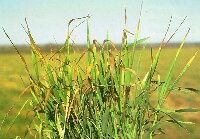
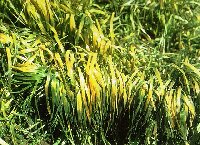 |
Leaves of freeze-injured plants. |
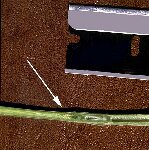  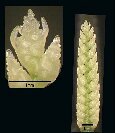
 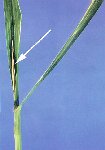
|
The most serious injury occurs to the growing points. The growing points can be located by splitting stems longitudinally with a sharp blade . A normal, uninjured growing point is bright yellow-green and turgid; freeze injury causes it to become white or brown and water soaked in appearance. This injury can occur even in plants that appear otherwise normal because the growing point is more sensitive to cold than that of other parts. Growth of stems in which the growing points are injured stop immediately. A chlorotic or dead leaf may appear in the whorl, indicating that the growing point is dead. Growth from later uninjured tillers may obscure damage. Partial injury at this stage may cause a mixture of normal tillers and late tillers and result in uneven maturity and some decrease in grain yield. |
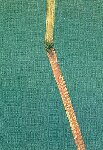 |
Injury to the lower stems in the form of discoloration, roughness, lesions, splitting, collapse of internodes, and enlargement of nodes frequently occurs at the jointing stage and the following stages after freezing. Injured plants often break over at the affected areas of the lower stem so that one or two internodes are parallel to the soil surface. |
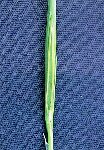  |
Stem injury does not appear to seriously interfere with ability of wheat plants to take up nutrients from the soil and translocate them to the developing grain. Injured areas might become infected by micro-organisms which can cause further stem deterioration. Lodging (falling over) of plants is the most serious problem following stem injury. Wind or hard rain can easily lodge the plants, deceasing grain yields and slowing harvest. With severe stem injury, splitting of stems and collapse of internodes is common. |
|
Wheat is in the boot stage and temperatures were below the critical 28 degrees for several hours. What kind of plant injury would you expect to see?
It is important to know the plant parts that are most vulnerable at each growth stage, where they are located on the plant, and their appearance when they are normal as well as when they have been injured. |

 |
Leaves of freeze-injured plants. |
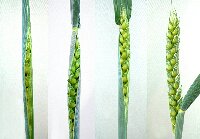 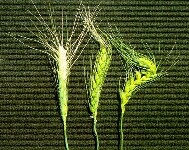 |
Freeze injury at this stage, when the heads are enclosed in the sheath or the flag leaves, causes a number of symptoms. Freezing may trap the head inside the boots so that they cannot emerge normally. When this happens, the heads will remain in the boots, split out the sides of the boots, or emerge base-first from the boots. |
 |
Sometimes spikes emerge normally from the boot after freezing, but remain yellow or even white instead of their usual green color. When this happens, the heads have been killed. |
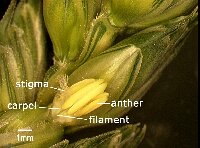
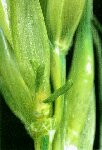
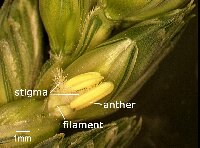
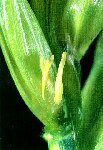
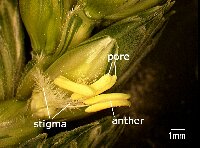

|
Frequently, only the male parts (anthers) of the flowers in the head are killed. Since wheat is self-pollinated, sterility caused by freeze injury causes poor kernel set and low grain yield. Injury can be detected soon after freezing by examining the anthers inside each floret. Anthers are normally light green and turgid when young and become yellow about the time they are extruded from the florets after anthesis or flowering. The anthers, still green, become twisted and shriveled within 48 hours after a freeze, but they turn white to whitish-brown quickly and may not be extruded from the florets. The female parts (stigma, style, and ovary) may be damaged, but if they are, the anther also will be injured. The stigma normally has a greenish-white, feathery appearance. A damaged stigma becomes off-white to brown and will not open. The ovary will also turn off-white to brown. Use of a hand lens will be helpful in detecting symptoms. |
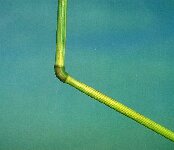 |
Many symptoms of freeze injury that occur at early stages might also be present at the boot stage. Leaves and lower stems might exhibit symptoms described for the jointing stage, but these plant parts are less sensitive than are the male flower parts. It is important, for this reason. to examine the anthers. Freezing temperatures that are severe enough to injure leaves and lower stems are nearly always fatal to male flower parts, but less severe freezing may cause male sterility without any symptoms appearing on plant vegetative parts (leaves and stems). |
| Wheat is in the heading stage and temperatures were below the critical 30 degrees for several hours. What kind of plant injury would you expect to see?
It is important to know the plant parts that are most vulnerable at each growth stage, where they are located on the plant, and their appearance when they are normal as well as when they have been injured. |

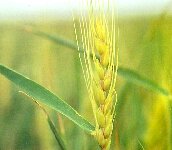 |
Wheat heads usually emerge from the boots during the first two weeks of May. Most symptoms of freeze injury at this stage are sterility, leaf desiccation or drying. Lesions on lower stems have symptoms that are similar to those at earlier growth stages. The most apparent symptom, however, is usually chlorosis or bleaching of the awns ("beard") so that they are white instead of the normal green color. Freezing temperatures that injure the awns will usually kill the male flower parts. |
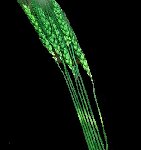 |
A light green or white "frost ring" may encircle the stems one to two inches below the heads several days after exposure to freezing temperatures. This area of yellowed chlorotic tissue marks the juncture of the stems and the flag leaves at the time that the freeze occurred. The frost ring may be present on injured plants as well as on plants that show no other symptom of injury. It does not seem to interfere with movement of nutrients from the plant to the developing grain. As the plants mature the heads may break over at the frost ring. That is most likely to happen to heads that are well filled, particularly during windy conditions. |
| Wheat is in the flowering stage and temperatures were below the critical 30 degrees for several hours. What kind of plant injury would you expect to see?
It is important to know the plant parts that are most vulnerable at each growth stage, where they are located on the plant, and their appearance when they are normal as well as when they have been injured.
Wheat usually flowers about one week after the heads appear. Symptoms of freeze injury at the flowering and heading stages are nearly similar.
The flowering stage is the most freeze-sensitive stage in wheat. Small differences in temperature, duration of exposure, or other conditions can cause large differences in amount of injury.
Exposure to freezing temperatures at the flowering stage kills the male parts of the flowers and causes sterility as described for the boot and heading stages. After freezing, the anthers are white and desiccated or shriveled instead of their normal yellow color.
Freeze injury at the flowering stage causes either complete or partial sterility, and void or partially filled heads because of the extreme sensitivity. |
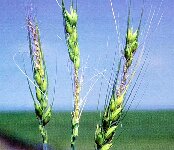 |
Flowering proceeds from florets near the center of wheat heads to florets at the top and bottom of the heads over a 2 to 4 day period. This small difference in flowering stage when freezing occurs may result in no grain being set in the center or one or both ends of the head. This lack of grain set may have resulted from male flowers in those florets being in a sensitive growth stage when the freeze occurred. Grain might develop in other parts of the spikes, however, because flowering had not started or was already completed in those florets when the freeze occurred. |
| Wheat is in the milk stage and temperatures were below the critical 28 degrees for several hours. What kind of plant injury would you expect to see?
It is important to know the plant parts that are most vulnerable at each growth stage, where they are located on the plant, and their appearance when they are normal as well as when they have been injured. |
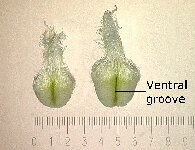
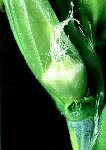
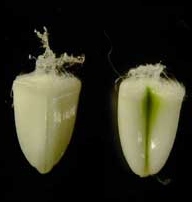
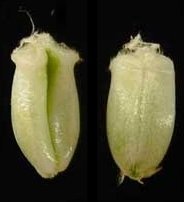
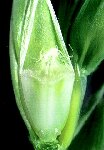
 |
Young developing kernels normally grow to full size (volume) within 12 to 14 days after flowering, but maximum grain weight is not reached for another two weeks. If young kernels fail to develop after freezing temperatures occurred, they likely have been injured. Injured kernels may be white or gray and have a rough, shriveled appearance instead of their normal light green, plump appearance. Cool weather frequently delays these other symptoms and failure of kernels to develop may be the major indication of injury. |
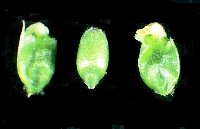 |
Kernels that are slightly injured at the milky ripe stage may grow to normal size, but produce light, shriveled grain at maturity. Examination of the kernels before maturity, at the early dough stage, may show that their contents are grey and liquid instead of white and viscous as they should be at this stage. The interior of the rachilla, the small stems that attach the spikelets to the stems, may also be dark instead or light-colored, so that the spikelets are easily stripped from the stems. These symptoms result from gradual deterioration of tissues and usually do not show up for a week or more after freezing occurred. |
| Wheat that has been injured by freezing at the milky-ripe stage often shatters easily at maturity, and the shriveled kernels cause the grain to have a low test weight. Germination percentage of the grain also may be seriously reduced as a result of freeze injury. |
| Wheat is in the dough stage and temperatures were below the critical 28 degrees for several hours. What kind of plant injury would you expect to see?
It is important to know the plant parts that are most vulnerable at each growth stage, where they are located on the plant, and their appearance when they are normal as well as when they have been injured.
Wheat kernels reach full size and nearly full weight by mid-dough stage in late May to early June. Because kernel development is nearly complete and kernel moisture content may have decreased, wheat is usually more resistant to freezing temperatures at this stage than at most earlier spring growth stages. The only visible sign of freeze injury at the dough stage may be an unsightly wrinkled appearance of the kernels and a slightly reduced test weight.
The most serious consequence of freeze injury at the dough stage is reduced germination of kernels. The embryo or germ usually has a higher moisture content than other kernel parts, and its' complex cellular content and structure makes it more vulnerable to freezing. |
Cotton
Cottonseed for variety tests can be picked up from the Texas A&M Research and Extension Center on May 4 after the training on Result Demonstrations and Applied Research. Attached is a copy of the result demonstrations planned for 2006.
Several of the postemerge herbicides used for broadleaf weed control will have to be applied using a directed sprayer. A layby treatment of trifluralin requires that the application be made onto the soil between the rows and beneath emerged cotton plants and can be tank-mixed for extended control. Be sure to read and follow the label directions. Producers other option is to use transgenic cotton that is resistant to either Roundup or Liberty herbicide.
Roundup Ready Cotton plants tolerate glyphosate herbicide. This allows the growers to work on annual weeds and perennial weeds (Silverleaf nightshade, Field Bindweed, and Horsenettle) without damaging the cotton. Roundup can be applied over-the-top of the cotton until the fifth true leaf stage. If Roundup is applied after the fifth true leaf stage it may cause sterility in the cotton. To be safe, growers will need to apply the herbicide underneath the canopy using a directed sprayer. With the introduction of Roundup Flex Cotton this season, producers will be able to spray over the top of these new transgenic lines for most of the growing season without reducing yield and achieve a higher level of weed control.
Staple herbicide can be applied over-the-top of any cotton variety, except those noted on the label. The price of Staple has been reduced and producers with morningglory infestations may want to use this herbicide alternative this season.
Anytime you write about products you should include a statement like "The information provided is for preliminary planning and not a guide for use. Be sure to read and follow the manufacture's label for complete directions for use."
The soil temperature this season is higher than usual. The minimum temperature for planting cotton is a ten day average of 600 F at the 8 eight inch depth. This temperature is taken at 8:00 a.m. each day. Cotton planted in warm soil, usually germinates and emerges faster and are healthier plants. So don't get in a rush. The weather station located east of San Angelo and east of Rowena records soil temperature and that information is posted on the web. The URLs are http://sanangelo.tamu.edu/weather/sjt/2006/ and http://sanangelo.tamu.edu/weather/runnels/2006/ .
Pesticide Recertification Training
On April 10, there will be a training conducted at Abilene for producers needing to obtain a Private Applicators license. For more details and to register for the meeting call Gary Bomar at (325) 672-6048.
Insect Scout School
The annual cotton insect scout school will be held June 5, 2006 at the Texas A&M Research and Extension Center at San Angelo. If you would like to travel to Taylor, Texas to fine-tune your scouting skills, please contact Rick Minzenmayer at (325) 365-5212.
Monthly Calendar
April 2006
 April 4, Nolan County, Multi-County Cotton Conference
April 4, Nolan County, Multi-County Cotton Conference
 April 6, Jones County, Multi-County Crop Production Meeting
April 6, Jones County, Multi-County Crop Production Meeting
 April 11, San Saba County, Multi-County Improved Pasture and Annual Forage Sorghum Meeting
April 11, San Saba County, Multi-County Improved Pasture and Annual Forage Sorghum Meeting
 April 13, Taylor County, Soil and Soil Fertility
April 13, Taylor County, Soil and Soil Fertility
 April 18-19, Kerr County, Agent Training on Forages
April 18-19, Kerr County, Agent Training on Forages
May 2005
 May 1, District Office, Office Conference
May 1, District Office, Office Conference
 May 2 & 3, Brown County, Professional Extension Board Meetings
May 2 & 3, Brown County, Professional Extension Board Meetings
 May 3 & 4, Agent Training on Result Demonstrations
May 3 & 4, Agent Training on Result Demonstrations
 May 5, Taylor and Callahan Counties, Wheat Tour
May 5, Taylor and Callahan Counties, Wheat Tour
 May 6, Tom Green County, District 7 4-H Roundup
May 6, Tom Green County, District 7 4-H Roundup
 May 9, Concho and McCulloch Counties, Wheat Tour
May 9, Concho and McCulloch Counties, Wheat Tour
 May 10, Runnels County, Wheat Tour
May 10, Runnels County, Wheat Tour
 May 10 - 12, Coleman County, District 7 TCAAA Meeting
May 10 - 12, Coleman County, District 7 TCAAA Meeting
 May 12, Annual Leave
May 12, Annual Leave
 May 18 & 19, Tom Green County, Kids, Kows and More
May 18 & 19, Tom Green County, Kids, Kows and More
|
Sincerely,
Billy E. Warrick
Extension Agronomist
Texas Cooperative Extension
Texas A&M University System
|



 April 4, Nolan County, Multi-County Cotton Conference
April 4, Nolan County, Multi-County Cotton Conference
 April 6, Jones County, Multi-County Crop Production Meeting
April 6, Jones County, Multi-County Crop Production Meeting
 April 11, San Saba County, Multi-County Improved Pasture and Annual Forage Sorghum Meeting
April 11, San Saba County, Multi-County Improved Pasture and Annual Forage Sorghum Meeting
 April 13, Taylor County, Soil and Soil Fertility
April 13, Taylor County, Soil and Soil Fertility
 April 18-19, Kerr County, Agent Training on Forages
April 18-19, Kerr County, Agent Training on Forages
 May 1, District Office, Office Conference
May 1, District Office, Office Conference
 May 2 & 3, Brown County, Professional Extension Board Meetings
May 2 & 3, Brown County, Professional Extension Board Meetings
 May 3 & 4, Agent Training on Result Demonstrations
May 3 & 4, Agent Training on Result Demonstrations
 May 5, Taylor and Callahan Counties, Wheat Tour
May 5, Taylor and Callahan Counties, Wheat Tour
 May 6, Tom Green County, District 7 4-H Roundup
May 6, Tom Green County, District 7 4-H Roundup
 May 9, Concho and McCulloch Counties, Wheat Tour
May 9, Concho and McCulloch Counties, Wheat Tour
 May 10, Runnels County, Wheat Tour
May 10, Runnels County, Wheat Tour
 May 10 - 12, Coleman County, District 7 TCAAA Meeting
May 10 - 12, Coleman County, District 7 TCAAA Meeting
 May 12, Annual Leave
May 12, Annual Leave
 May 18 & 19, Tom Green County, Kids, Kows and More
May 18 & 19, Tom Green County, Kids, Kows and More